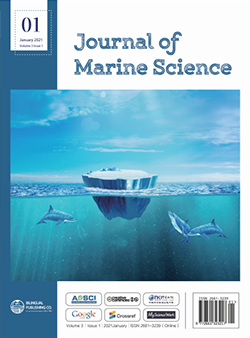Mass Spectrometry-based Sequencing of Venom Peptides (Conotoxins) from Vermivorous Cone Snail, Conus Loroisii: Toxicity of its Natural Venom
DOI:
https://doi.org/10.30564/jms.v3i1.2416Abstract
Conus loroisii is a marine vermivorous snail found profusely in the southern seas of India. They harbor several toxic peptide components commonly called as ‘conotoxins’. In this study, we have identified and sequenced five conotoxins using proteome based tandem mass spectrometry analysis through Data analysis 4.1 software. Among them, we found Lo959 as contryphan which is previously described. All other conotoxins Lo1702, Lo1410, Lo1385 and Lo1686 belong to M-Superfamily conotoxins and novel to C. loroisii. Lo1410 is completely novel to conotoxin research with 3 disulfides and the amino acid sequence is derived as CCSTNCAVCIPCCP. All the identified M-Superfamily conotoxins are sub categorised to mini M2 superfamily conotoxins. Lo1702 and Lo1686 possess C- terminal amidation which is the key feature in conotoxins. Moreover, we have screened the natural venom for the occurrence of toxicity in the zebrafish model and brine shrimp.
Keywords:
Conus loroisii, Conotoxins, Toxicity, Mass spectrometryReferences
[1] Röckel, D., Korn W, Kohn, A.J. Manual of the Living Conidae. Wiesbaden, Hemmen. 1995.
[2] Staats, Peter S., Thomas Yearwood, Steven G. Charapata, Robert W. Presley, Mark S. Wallace, Michael Byas Smith, Robert Fisher. Intrathecal ziconotide in the treatment of refractory pain in patients with cancer or AIDS: a randomized controlled trial. JAMA, 2004, 1: 63-70.
[3] Bruce, G., Livett David, W., Sandall, David Keays, John Down, Ken R. Gayler, Narmatha Satkunanathan, Zeinab Khalil. Therapeutic applications of conotoxins that target the neuronal nicotinic acetylcholine receptor, Toxicon, 2006, 48(7): 810-829. https://doi.org/10.1016/j.toxicon.2006.07.023Get rights and content
[4] Olivera, B.M., Walker, C., Cartier, G.E., Hooper, D., Santos, A.D., Schoenfeld, R., Shetty, R., Watkins, M., Bandyopadhyay, P., Hillyard, D.R. Specification of cone snails and interspecific hyperdivergence of their venom peptides. Potential evolutionary significance of introns. Ann. N.Y. Acad. Sci., 1999, 870: 223.
[5] Kaas, Quentin. Conopeptide Characterization and Classifications: An Analysis Using Cono Server. Toxicon, 2010, 55(8): 1491-1509.
[6] Olivera, B.M., Showers Corneli, P., Watkins, M., Fedosov, A. Biodiversity of Cone Snails and other Venomous Marine Gastropods: Evolutionary Success through Neuropharmacology. Annual Review of Animal Biosciences, 2014, 2: 487-513.
[7] McIntosh, J.M., Olivera, B.M., Cruz, L.J., Conus peptides are probes for ion channels. Methods in Enzymology, 1999, 294: 605-624. https://doi. org/10.1016/S0076-6879(99)94034-X
[8] Franklin, J., Benjamin, K.A., Subramanian, S., Antony Fernando, Krishnan, K.S. Diversity and distribution of conidae from the Tamil Nadu coast of India (Mollusca: Caenogastropoda: Conidae). Zootaxa, 2009, 2250: 3-63.
[9] Rajesh, R. P. Novel M-Superfamily and T-Superfamily conotoxins and contryphans from the vermivorous snail Conus figulinus, Journal of Peptide Science, 2014, 21: 29–39. https://doi.org/10.1002/psc.2715
[10] Kumar, A., Bhardwaj, M., Kaur, H. Possible role of neuroprotectants and natural products in epilepsy: Clinical aspects and mode of action, neuroprotective natural products, 2017, 2: 247-277.
[11] Schmidt, D. Antiepileptic Drugs. Handbook of Experimental Pharmacology. Springer, 1985, 74: 791-829.
[12] Lamthanh, Hung, Christelle Jegou-Matheron, Denis Servent, André Ménez, Jean-Marc Lancelin. Minimal conformation of the α-conotoxinImI for the α7 neuronal nicotinic acetylcholine receptor recognition: correlated CD, NMR and binding studies. FEBS letter, 1999, 454 (3): 293-298.
[13] Jackson, Helen, C., Mark, A., Scheideler. Behavioral and anticonvulsant effects of Ca 2+ channel toxins in DBA/2 mice. Psychopharmacology, 1996, 126 (1): 85-90.
Downloads
Issue
Article Type
License
Copyright and Licensing
The authors shall retain the copyright of their work but allow the Publisher to publish, copy, distribute, and convey the work.
Journal of Marine Science publishes accepted manuscripts under Creative Commons Attribution-NonCommercial 4.0 International License (CC BY-NC 4.0). Authors who submit their papers for publication by Journal of Marine Science agree to have the CC BY-NC 4.0 license applied to their work, and that anyone is allowed to reuse the article or part of it free of charge for non-commercial use. As long as you follow the license terms and original source is properly cited, anyone may copy, redistribute the material in any medium or format, remix, transform, and build upon the material.
License Policy for Reuse of Third-Party Materials
If a manuscript submitted to the journal contains the materials which are held in copyright by a third-party, authors are responsible for obtaining permissions from the copyright holder to reuse or republish any previously published figures, illustrations, charts, tables, photographs, and text excerpts, etc. When submitting a manuscript, official written proof of permission must be provided and clearly stated in the cover letter.
The editorial office of the journal has the right to reject/retract articles that reuse third-party materials without permission.
Journal Policies on Data Sharing
We encourage authors to share articles published in our journal to other data platforms, but only if it is noted that it has been published in this journal.




 Humaira Saleh Syed
Humaira Saleh Syed


